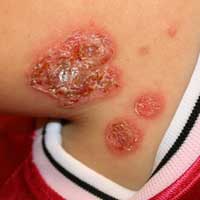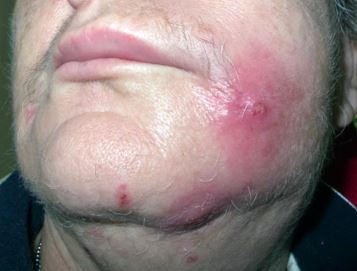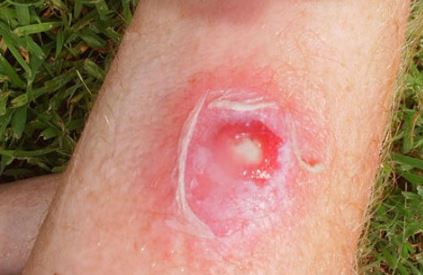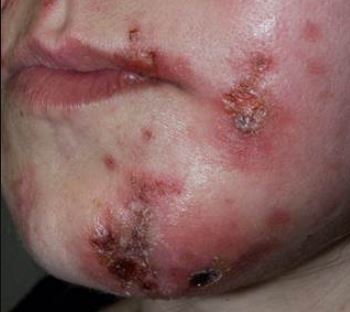What is a Staph Infection?
Staph is a short form of the term Staphylococcus and it’s a type of bacteria. On the skin surface of a person, there are many bacteria that live harmlessly, especially around the anus, genitals, mouth, and nose. While these bacteria remain harmless, whenever the skin is broken or punctured, they find their way into the wound or flesh thus causing an infection. There are more than 30 species within the staph family. Most staph infection is a culprit of Staphylococcus aureus or S. aureus. With these types of bacteria, they cause skin infections that tend to be limited to some small area for example, impetigo, boils, folliculitis, and cellulitis.
Staphylococcus aureus may also release poisons or toxins in the body resulting in illnesses such as toxic shock syndrome or food poisoning. 1,2,5


What’s Staphylococcus?
It’s a bacteria genus that has a round shape hence the term ‘coccus’ in its name. The bacteria genus is gram-stain positive and it can be found within single cells or in pairs but most frequently, it is appears in clusters resembling bunches of grapes.
Staphylococcus is Greek term picked from staphyle and kokkos, which indicate a bunch of grapes. So after gram-staining, that’s how the bacteria appear under a microscope. Staphylococcus was first described by Rosenbach in 1884. Two main groups of Staphylococcus are those that produce coagulase and those that don’t. Coagulase is an enzyme that helps clot blood and most bacterial infections in humans are caused by this group of bacteria or simply strains of Staphylococcus aureus that are coagulase positive. The other group consists of coagulase-negative Staphylococcus known as S. epidermidis and these tend to produce some slime that affects the immune system. S. epidermidis is commonly seen affecting areas where there are implanted devices such as prosthetic and catheters.2
S. epidermidis strains don’t usually cause infections, however in people with suppressed immune system, they may get infection from this genus of bacteria.
What’s The Cause of Staph Infection?
The genus of bacteria called S. aureus can affect almost any body organ but most frequently, it infects the skin and the structures found in it for instance, hair follicles and sebaceous glands. It also infects damaged skin like abrasions and cuts. Infections caused by S. aureus can be localized or limited, for example a boil, sty, carbuncle or furuncle. Other times, the infection may spread to affect other areas of the skin for example, in the case of impetigo, folliculitis, and cellulitis. Sometimes, the bacteria may enter the bloodstream a condition known as bacteremia, and travel to many parts of the body causing infections such as endocarditis, abscesses, wounds, osteomyelitis, and pneumonia. These infections could be severe or even fatal if not treated. 2,5
Staph Infection Symptoms
People who have staph infections show symptoms and signs like a swollen, itchy, and reddish, or tender skin. Often, the infected area will ooze pus or it may have crusty covering with some drainage. The infected site may be small for example, a pimple on the face or nose, or a boil forming on the extremity. The infected site may also be large for example, carbuncle. Other symptoms and signs may include: 2
- Scalded skin syndrome – this manifests in the form of extensive skin redness occurring along with bullae or pus-filled blisters.
- Cullulitis – this commonly appears on an individual’s legs and shows swelling of the affected area but without pus. In the case of impetigo, it shows crusty weeping rash that may be accompanied by an occasional blister.
- If a patient has infected implanted devices like catheters, the symptoms present in form of redness, tenderness, and pus within the skin entry area.
- There may be invisible signs on the outside, which can be seen by imaging techniques like X-ray, for example, pneumonia, abscesses, osteomyelitis, and other infections occurring internally.
- Others may not be visible, for example food poisoning and toxic shock
- A patient may also experience vomiting, nausea, abdominal pain, diarrhea, and chills or fever.
It is important to note that these signs and symptoms only suggest a staph infection. Therefore, a doctor should conduct tests such as bacterial culture to identify the infecting agent.
Spread
You may get staph infection if you come in contact with contaminated objects, however, most infections from one person to another happen through skin-to-skin contact. It is also possible for the bacteria causing staph infection to spread from one part of the body to a different part after a person touches an infected area.
In persons living in groups for example, college dorms, it is possible for the infection to spread after individuals or students share personal items like clothing, towels, and linens. People living in humid environments may have staph infection because of excessive sweating, which increases a person’s chance of developing the infection. If you have skin problems such as eczema and burns, you may also have an increased risk of getting staph infections.1,3
About 25 percent of individuals have Staphylococcus on their mouth, nose, anal, and genital areas and they usually don’t show symptoms of an infection. A person’s foot is susceptible to picking up bacteria, especially on floor or from soiled surfaces like socks or shoe bases. Infections may begin when a person has a cut that becomes infected with the bacteria. The infection will look like some honey-yellow crusts forming on the skin.
Staph infections may range from simple forms like a boil to the so-called MRSA or simply methicillin-resistant Staphylococcus aureus. There are also flesh-eating infections from bacteria. Much of the difference between the various forms of infections is based on the strength of infection, the rate of spreading, how deep it affects the area, and how treatable it is using antibiotics. In areas where there is overuse of antibiotics, the antibiotic-resistant infections may be more common.3
Diagnosis
A doctor will order for culture of the bacteria from samples picked at the infected area. Any area containing pus or with crusty drainage and blisters need to be cultured. Blood culture is also done in patients having toxic shock syndrome, sepsis, or pneumonia caused by bacteria. A positive coagulase test is a standard microbiological technique that helps show staph infection. Staphylococcus aureus lyses erythrocytes or red blood cells within hemolytic staph or blood agar plates but S. epidermidis usually does not.2,6
It is important that further tests are conducted to find if the bacteria could be resistant to antibiotics like methicillin. This helps determine whether the microbes are MRSA.
Treatment
Treatment for staph infections may be done surgically or with use of antibiotics. Most patients needing surgical treatment for staph infections, antibiotics may also be needed. A doctor performing surgical treatment does incisions and drains pus. The sources of infections may also be removed surgically such as artificial grafts, pacemakers, heart valves, or intravenous lines.
Surgery may also be needed in other sites of staph infection for example, joint infections particularly in children or postoperative abscesses and osteomyelitis.
Antibiotics effective for treating non-MRSA staph infections include:
- doxycycline
- trimethoprim
- clindamycin
- dicloxacillin
- cefazolin
- nafcillin
In case of MRSA microbes, other antibiotics may be required. If a person has minor skin infections, treatment for MRSA infections include use of Bacitracin administered orally. For serious MRSA infections, treatment may be done using a combination of antibiotics such as sulfamethoxazole-trimethoprim, linezolid, vancomycin, or rifampin.
How Contagious is Staph Infection?
Healthy people may have bacteria colonization making it almost impossible for individuals to prevent getting in contact with the bacteria. Transmission is mostly by contact when a person gets close or in contact with another who has staph bacteria. You may also contract staph on surfaces of sinks, clothing, and other objects if they get in contact with the skin. The bacteria are contagious as long as an individual has an active infection. You can reduce the risk of having the infection by avoiding skin scratches, puncture wounds, or abrasions. And if these occur, you should clean and treat the skin immediately using antibacterial agents to prevent infections.
Prevention
The best way to prevent staph infections is ensuring cleanliness. Because the bacteria are everywhere, if you don’t observe properly hygiene, you may be susceptible to infections. You can wash your hands frequently and bath or shower every day. If you have staph infection occurring in areas that you shave, it’s important to avoid shaving until you have the infection gone. In the event that you have to shave, then it is recommended you use clean disposable razors. If you use electric razor to shave, make sure that you clean them properly.
If there is a family member with a staph infection, you are advised to stop sharing sheets, towels, or clothing with them until you make sure that the infection is treated properly. See a doctor if the infections are spreading among family members or if more than one person in the family suffer from skin infections concurrently.
Other prevention measures include:
- If you have wounds keep them covered
- Wash your clothing and bedding using hot water
- Tampons that have been left for a long time could form a breeding ground for the bacteria, so ensure you change the tampon frequently to avoid getting toxic shock syndrome
Pictures





Reference List
- What Is a Staph Infection? https://kidshealth.org/en/teens/staph.html
- Staph Infection (Staphylococcus Infection) https://www.emedicinehealth.com/staphylococcus/article_em.htm#where_can_people_find_more_information_on_staph_infections
- Staph Infection and Cellulitis. https://www.webmd.com/skin-problems-and-treatments/guide/staph-infection-cellulitis#1
- Staph infections. https://www.mayoclinic.org/diseases-conditions/staph-infections/symptoms-causes/syc-20356221
- Staphylococcal Infections. https://medlineplus.gov/staphylococcalinfections.html
- Diagnosis and Treatment of Staphylococcus aureus http://www.health.state.mn.us/divs/idepc/diseases/staph/treat.html
- About Staph Infections. https://kidshealth.org/en/parents/staphylococcus.html
